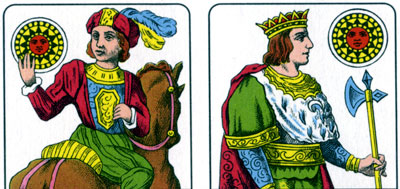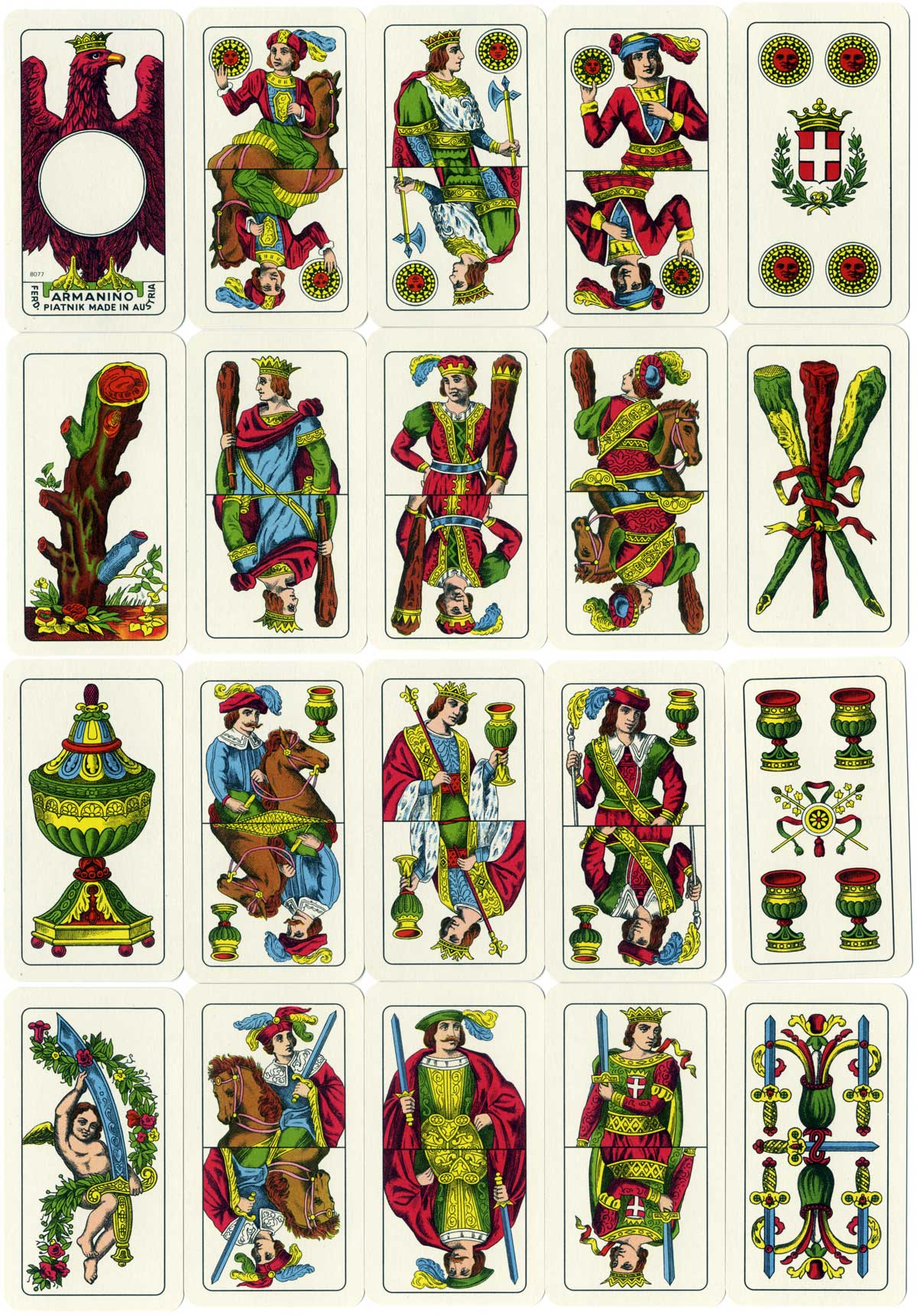Piacentine Pattern
Piacentine Pattern, several double-ended versions.

The Italian ‘Piacentine’ pattern has Italo-Spanish suit symbols and slightly narrow, elongated cards. It was made in single-ended format until around the mid-20th century after which time double-ended versions are more usual. When this happens some features of the old cards are lost. The Ace of Coins used to bear the tax stamp, and shows a single-headed, crowned eagle (as opposed to the Neapolitan double-headed eagle). Cards of Spanish design occur in those parts of Italy formerly under Spanish influence (Neapolitan, Piacentine, Romagnole, Sardinian and Sicilian patterns) although the ‘pintas’ or line-breaks in the outer frames have been lost. Early examples of the Piacentine pattern also have features related to French Aluette cards.
Modiano, Trieste

Above: double-ended example of Piacentine pattern made by Modiano, Trieste. The King of Coins holds an axe and the Cavalier of Coins rides a horse with its back facing the viewer, features which were seen in some archaic, late-medieval Spanish-suited patterns see example →. Images kindly supplied by Anthony Lee.
Armanino (Piatnik) c.1977

Above: double-ended Piacentine pattern made by Armanino (Piatnik) c.1977
Standard designs printed by Piatnik for Tobako, Milan, Italy, 1980.
Looking at the tuck box for this pack one has no idea who made the cards inside. However, the 4 of Coins leaves us in no doubt – Piatnik of Austria. Their characteristic date mark helpfully appears at the base of the Ace of Coins. This version of the Piacentine pattern by Piatnik is quite different from the one they made for Armanino (above). The courts are double-ended. See the box►


Above: double-ended Piacentine pattern made by Piatnik for Tobako, Milan, c.1980. 40 cards in tuck box. Size: 51 x 91 mm. Images and notes courtesy Roddy Somerville.
NOTE: presumably TOBAKO was a chain of tobacconists in Milan but I can find no information about them.

By Simon Wintle
Member since February 01, 1996
I am the founder of The World of Playing Cards (est. 1996), a website dedicated to the history, artistry and cultural significance of playing cards and tarot. Over the years I have researched various areas of the subject, acquired and traded collections and contributed as a committee member of the IPCS and graphics editor of The Playing-Card journal. Having lived in Chile, England, Wales, and now Spain, these experiences have shaped my work and passion for playing cards. Amongst my achievements is producing a limited-edition replica of a 17th-century English pack using woodblocks and stencils—a labour of love. Today, the World of Playing Cards is a global collaborative project, with my son Adam serving as the technical driving force behind its development. His innovative efforts have helped shape the site into the thriving hub it is today. You are warmly invited to become a contributor and share your enthusiasm.
Related Articles

Late flowering of the Lyon pattern
Faustino Solesio’s late version of the Lyon pattern from about 1870.

Czech National Patterns by S.D. Modiano
Modiano produced cards with the Prague and Trappola patterns in the early 20th century.

Emilio Tadini playing cards
Beautiful dreamlike playing card designs by Emilio Tadini.

Austrian Tarock by S.D. Modiano
Modiano’s Austrian Tarock with country scenes has been in production for over 100 years.

Le carte da gioco Arcimboldo
Courts and suit-signs inspired by the works of the Italian Renaissance painter, Giuseppe Arcimboldo....

Ukraine playing cards
Historical figures from Ukraine’s past in a familiar Piatnik style.

22 Pittori in 22 Arcani
Collaborative Tarot with contributions from 22 different Italian artists including Menegazzi and Tav...

Justice playing cards
Ethical concepts in a deck produced by Riccardo Conturbia’s Passione Playing Cards Ltd.

Alan Tarot Deck
Reprint of a Tarock pack originally designed by Argio Orell for the Austrian Lloyd shipping company....

Il Tarocco del Mondo Nuovo
Imaginative Tarot card designs by Amerigo Folchi relating to Columbus and the New World.

22 Artisti Liguri in 22 Arcani
Collaborative set of major arcana devoted to Christopher Columbus and his voyages of discovery.

Carte di Colombo
Fully illustrated pack designed by Pier Canosa commemorating the 500th anniversary of the discovery ...

Carte di Natale
Designed by Pier Canosa as a Christmas pack for the Cortina Art Gallery in Milan.

Play Architecture
Twentieth century architects and their creations on a well-designed pack from Finland.

Lyon pattern made in Italy by Pietro de Santi
The Lyon pattern was initially developed in France during the 16th century. As Lyon was a trading hu...

Laurenzo Propagine
Spanish-suited cards made in Italy by Laurenzo Propagine.
Most Popular
Our top articles from the past 28 days

